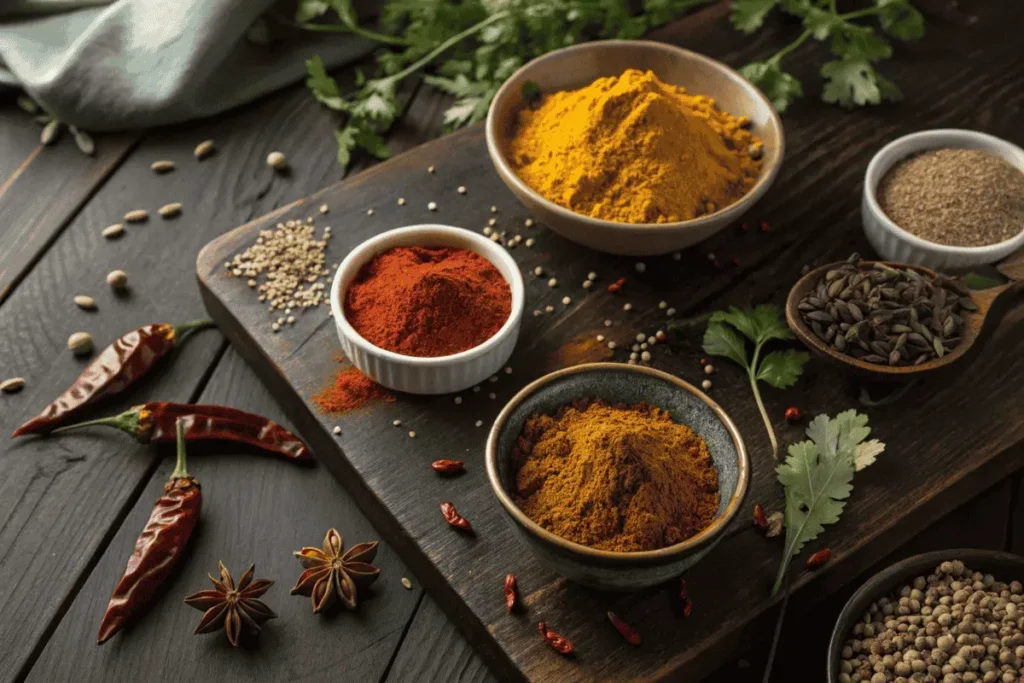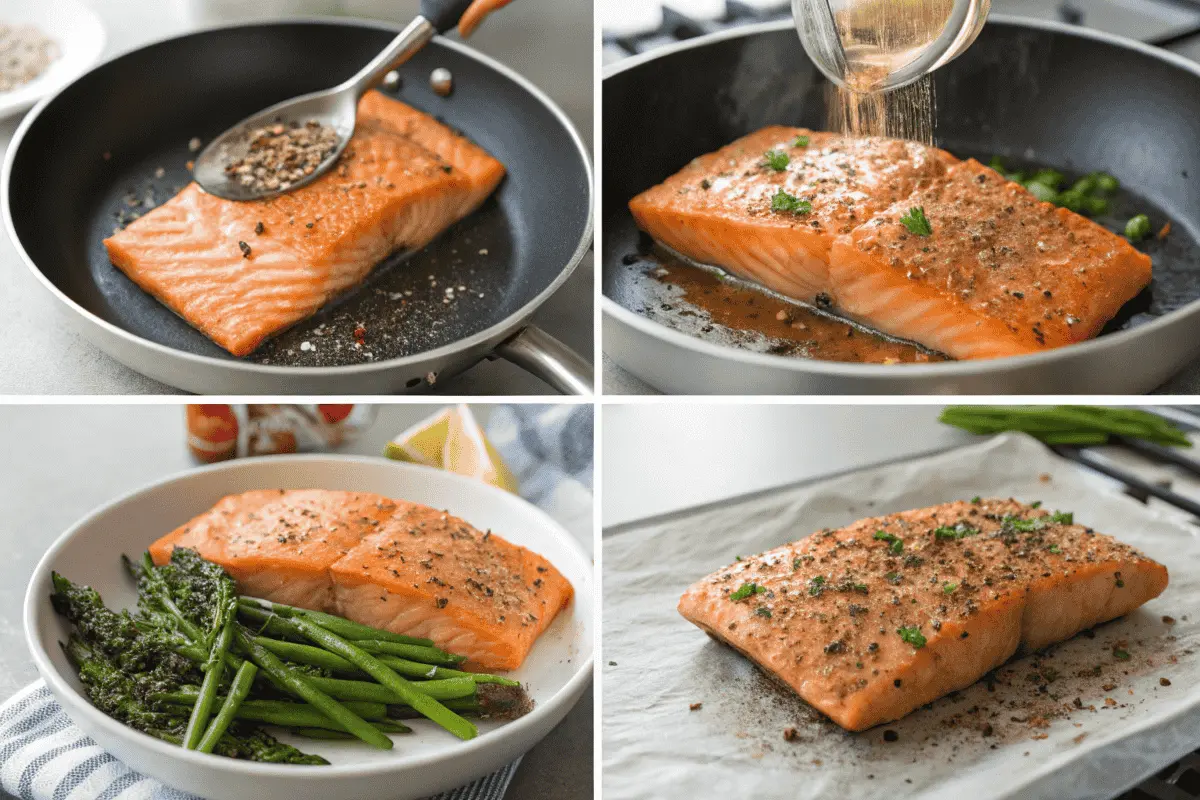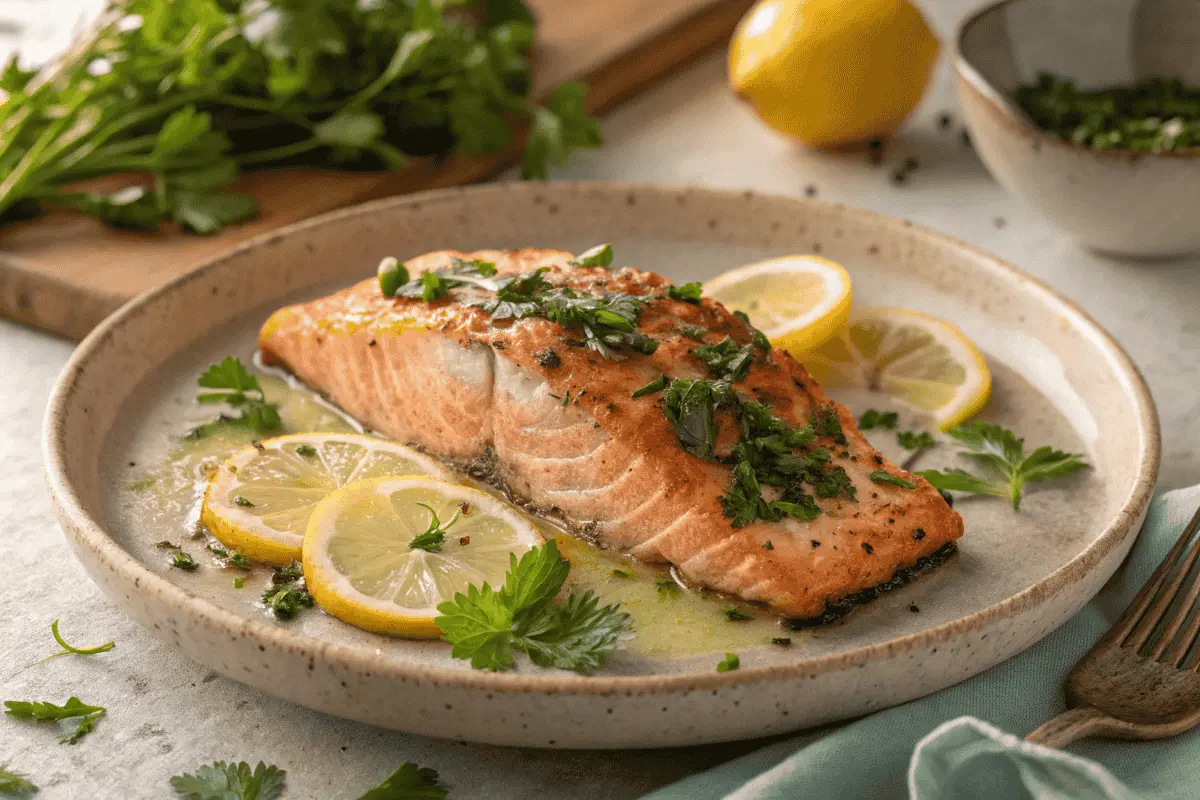Ever wandered through a spice market in Marrakech, taking in the vibrant colors and aromatic scents? While we can’t all jet off to Morocco, this 20-minute moroccan salmon recipe brings those mesmerizing North African flavors right to your kitchen. Tired of the same old salmon recipes? Let me show you how to transform an ordinary piece of fish into an extraordinary meal that will transport your taste buds to the bustling souks of Casablanca.
Table of Contents
A Journey Through Moroccan Cuisine (Cultural Context)
Moroccan cuisine is renowned for its bold spices, fresh ingredients, and the perfect balance between sweet and savory flavors. Traditional Moroccan cooking combines influences from Mediterranean, Arabic, and Berber cultures, creating a unique culinary heritage that has evolved over thousands of years.
The use of spices in Moroccan cooking isn’t just about flavor it’s about creating harmony in dishes while providing numerous health benefits. Each spice in our recipe carries centuries of culinary tradition and medicinal properties.
What Makes This Recipe Special
This Moroccan Salmon Recipe stands out for several reasons:
- Quick preparation (20 minutes total)
- Uses readily available ingredients
- Perfectly balanced flavor profile
- Suitable for both weeknight dinners and special occasions
- Highly nutritious and heart-healthy
- Adaptable to different cooking methods
- Beginner-friendly yet impressive results
Difficulty Level: Easy to Moderate
Even novice cooks can master this dish with our detailed instructions. The most challenging part is timing the cook on the salmon, but we’ll guide you through it step by step.
Essential Ingredients and Their Roles
The Star: Salmon (Choose the Right Cut)
- Center-cut salmon fillets (6 oz each)
- Look for bright pink color
- Avoid fillets with gray areas or strong fishy smell
- Wild-caught preferred for better flavor and nutrition
- Skin-on helps maintain moisture during cooking
The Moroccan Spice Blend (Detailed Breakdown)
Base Spices:
- 2 teaspoons ground cumin (adds earthiness and warmth)
- 2 teaspoons paprika (provides color and sweet pepper flavor)
- 1 teaspoon ground coriander (offers citrusy notes)
- 1 teaspoon ground turmeric (gives golden color and anti-inflammatory properties)
- 1/2 teaspoon cinnamon (adds subtle sweetness)
- 1/2 teaspoon ginger powder (provides warmth and digestive benefits)
- 1/4 teaspoon cayenne pepper (adds controlled heat)
- 1 teaspoon garlic powder (delivers savory depth)
- 1 teaspoon onion powder (adds aromatic sweetness)
Additional Ingredients:
- 2 tablespoons extra virgin olive oil (for moisture and healthy fats)
- Fresh lemon juice (brightens flavors)
- Sea salt and freshly ground black pepper
- Fresh herbs for garnish

Ingredient Substitutions and Variations
- Salmon alternatives: Ocean trout or Arctic char
- Spice adjustments for heat sensitivity
- Fresh herbs vs. dried options
- Oil alternatives for different dietary needs
Comprehensive Step-by-Step Instructions

Step 1: Preparation Phase (5 minutes)
- Remove salmon from refrigerator 30 minutes before cooking
- Create spice blend:
- Measure all spices carefully
- Mix in a small bowl
- Store extra in airtight container
- Pat salmon dry thoroughly
- Check for pin bones
Step 2: Seasoning Process (5 minutes)
- Brush salmon with olive oil
- Apply spice mixture generously
- Press spices gently into flesh
- Let rest for optimal flavor absorption
Step 3: Cooking Methods (8 minutes)
Stovetop Method:
- Heat pan on medium-high
- Add oil until shimmering
- Place salmon skin-side up
- Cook 4 minutes until golden crust forms
- Flip carefully
- Cook 3-4 minutes more
Oven Method:
- Preheat to 400°F (200°C)
- Line baking sheet with parchment
- Bake 12-15 minutes
Grilling Method:
- Preheat grill to medium-high
- Oil grates well
- Grill 4-5 minutes per side
Step 4: Finishing and Presentation (2 minutes)
- Rest for 2-3 minutes
- Add fresh lemon juice
- Garnish with:
- Fresh cilantro
- Toasted almonds
- Lemon wedges
- Fresh herbs
Professional Tips for Perfect Results
- Temperature control is crucial
- Watch for visual cues of doneness
- Use a fish spatula for turning
- Don’t overcrowd the pan
- Monitor internal temperature
- Let rest before serving
Storage and Make-Ahead Guidelines
Storage Instructions:
- Refrigerate leftover salmon up to 2 days
- Store spice mix up to 3 months
- Keep garnishes separate
Make-Ahead Tips:
- Prepare spice mix in advance
- Measure garnishes ahead
- Pre-cut lemon wedges
- Season salmon up to 2 hours before cooking
Creative Recipe Variations
Spice Level Variations:
- Mild: Reduce cayenne
- Medium: Follow recipe as written
- Spicy: Double cayenne
Regional Adaptations:
- Mediterranean Style:
- Add oregano
- Include fresh basil
- Incorporate lemon zest
- Middle Eastern Twist:
- Add za’atar
- Include sumac
- Top with pomegranate seeds
- Moroccan Royal Style:
- Add preserved lemon
- Include olives
- Top with chermoula
Perfect Pairings and Side Dishes
Grain Accompaniments:
- Fluffy couscous
- Quinoa pilaf
- Brown rice
- Bulgur wheat
Vegetable Sides:
- Roasted Mediterranean vegetables
- Moroccan carrot salad
- Grilled zucchini
- Roasted sweet potatoes
Sauce Options:
- Yogurt-based sauce
- Tahini sauce
- Chermoula
- Harissa (on the side)
Health Benefits and Nutrition
Nutritional Highlights:
- High in omega-3 fatty acids
- Rich in protein
- Excellent source of vitamin D
- Contains beneficial antioxidants
Health Benefits:
- Heart Health:
- Reduces inflammation
- Supports cardiovascular function
- Maintains healthy cholesterol levels
- Brain Function:
- Supports cognitive health
- Enhances memory
- Promotes brain development
- Anti-inflammatory Properties:
- Turmeric benefits
- Ginger properties
- Antioxidant effects
Troubleshooting Guide
Common Issues and Solutions:
- Salmon too dry:
- Watch cooking time
- Check internal temperature
- Don’t overcook
- Spices burning:
- Adjust heat level
- Monitor carefully
- Use enough oil
- Uneven cooking:
- Even thickness important
- Room temperature before cooking
- Proper pan heat
Extended FAQs
Q: Can I use frozen salmon? A: Yes, thaw completely and pat dry before cooking.
Q: How do I store leftover spice mix? A: In an airtight container in a cool, dark place.
Q: Can I meal prep this recipe? A: Yes, but best served fresh. Store components separately.
Q: What’s the best salmon to use? A: Wild-caught salmon offers the best flavor and nutrition.
Q: How do I prevent the salmon from sticking? A: Ensure pan is hot and well-oiled before adding fish.
If you’re interested in exploring other salmon meals, take a look at Honey Pineapple Salmon for more ideas.
Conclusion
This Moroccan Salmon Recipe proves that creating an impressive, flavorful meal doesn’t require hours in the kitchen. By combining fresh ingredients with traditional Moroccan spices, you can create a dish that’s both healthy and delicious in just 20 minutes. Whether you’re cooking for family or entertaining guests, this recipe offers the perfect balance of simplicity and sophistication.
Remember, cooking is about experimentation and finding what works best for you. Don’t be afraid to adjust the spices to your taste preferences. The joy of cooking lies in making each recipe your own while respecting its cultural roots.
Share your creations with us and let us know how you’ve made this recipe uniquely yours. Happy cooking, and enjoy your culinary journey to Morocco!

